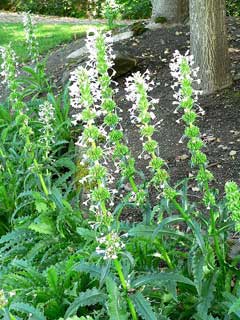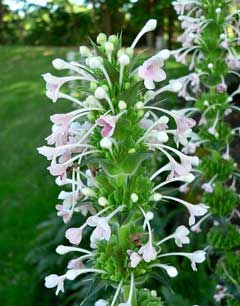 |
|
http://commons.wikimedia.org/wiki/User:Stan_Shebs |
 |
| http://commons.wikimedia.org/wiki/User:Stan_Shebs |
Translate this page:
Summary
Physical Characteristics

 Morina longifolia is an evergreen Perennial growing to 0.6 m (2ft) by 0.3 m (1ft in).
Morina longifolia is an evergreen Perennial growing to 0.6 m (2ft) by 0.3 m (1ft in).
See above for USDA hardiness. It is hardy to UK zone 6. It is in leaf all year, in flower from June to July. The species is hermaphrodite (has both male and female organs) and is pollinated by Moths. The plant is self-fertile.
Suitable for: light (sandy) and medium (loamy) soils and prefers well-drained soil. Suitable pH: mildly acid, neutral and basic (mildly alkaline) soils. It can grow in semi-shade (light woodland) or no shade. It prefers moist soil.
UK Hardiness Map
US Hardiness Map
Synonyms
Plant Habitats
Woodland Garden Sunny Edge; Cultivated Beds;
Edible Uses
References More on Edible Uses
Medicinal Uses
Plants For A Future can not take any responsibility for any adverse effects from the use of plants. Always seek advice from a professional before using a plant medicinally.
Digestive Emetic Stomachic
The stem, leaves and flowers are used in Tibetan medicine, they are said to have a sweet and astringent taste with a heating potency[241]. They are digestive, emetic and stomachic, and are used in the treatment of stomach disorders such as indigestion giving rise to vomiting and nausea[241].
References More on Medicinal Uses
The Bookshop: Edible Plant Books
Our Latest books on Perennial Plants For Food Forests and Permaculture Gardens in paperback or digital formats.

Edible Tropical Plants
Food Forest Plants for Hotter Conditions: 250+ Plants For Tropical Food Forests & Permaculture Gardens.
More

Edible Temperate Plants
Plants for Your Food Forest: 500 Plants for Temperate Food Forests & Permaculture Gardens.
More

More Books
PFAF have eight books available in paperback and digital formats. Browse the shop for more information.
Shop Now
Other Uses
References More on Other Uses
Cultivation details
Requires a fertile, humus-rich, moisture retentive but well-drained sandy or gritty soil in a sunny position[1, 111, 200]. It grows best with a little shade and shelter from high winds[1]. Prefers a slightly acid soil[175]. A very ornamental plant[1], the leaves are spicily aromatic[187]. A fairly easy plant to grow, though it tends to be short-lived[187]. It is hardy to about -17°c when growing in a perfectly drained soil[187, 200]. It grows best in the western side of Britain, sometimes succumbing to cold in the south-east of the country[233]. Requires protection from slugs[K]. The flowers open in the evening and are pollinated by moths. If pollination does not take place by morning then the top of the pistil curves over and effects self-pollination[211]. Resents root disturbance[200].
References Carbon Farming Information and Carbon Sequestration Information
Temperature Converter
Type a value in the Celsius field to convert the value to Fahrenheit:
Fahrenheit:
The PFAF Bookshop
Plants For A Future have a number of books available in paperback and digital form. Book titles include Edible Plants, Edible Perennials, Edible Trees,Edible Shrubs, Woodland Gardening, and Temperate Food Forest Plants. Our new book is Food Forest Plants For Hotter Conditions (Tropical and Sub-Tropical).
Shop Now
Plant Propagation
Seed - best sown as soon as it is ripe in individual pots to minimize disturbance to the tap root. Overwinter in a well ventilated cold frame[200]. Sow stored seed in early spring in a cold frame[111]. Plant out into their permanent positions in the summer when the plants are at least 15cm tall. Division in spring is possible but very difficult. Divided plants are often extremely slow to re-establish[200]. It is best carried out immediately after the plant flowers[188]. Root cuttings in individual pots in November. Plants are quick to produce foliage but slow to form roots. They are best left in pots for 12 months before planting out[175].
Other Names
If available other names are mentioned here
Native Range
TROPICAL ASIA: Bhutan, India (Himachal Pradesh, Jammu and Kashmir, Sikkim, Uttar Pradesh), Nepal, Pakistan (north)
Weed Potential
Right plant wrong place. We are currently updating this section.
Please note that a plant may be invasive in one area but may not in your area so it's worth checking.
Conservation Status
IUCN Red List of Threatened Plants Status :

Growth: S = slow M = medium F = fast. Soil: L = light (sandy) M = medium H = heavy (clay). pH: A = acid N = neutral B = basic (alkaline). Shade: F = full shade S = semi-shade N = no shade. Moisture: D = dry M = Moist We = wet Wa = water.
Now available:
Food Forest Plants for Mediterranean Conditions
350+ Perennial Plants For Mediterranean and Drier Food Forests and Permaculture Gardens.
[Paperback and eBook]
This is the third in Plants For A Future's series of plant guides for food forests tailored to
specific climate zones. Following volumes on temperate and tropical ecosystems, this book focuses
on species suited to Mediterranean conditions—regions with hot, dry summers and cool, wet winters,
often facing the added challenge of climate change.
Read More
Expert comment
Author
Wall.
Botanical References
51200
Links / References
For a list of references used on this page please go here
Readers comment
© 2010, Plants For A Future. Plants For A Future is a charitable company limited by guarantee, registered in England and Wales. Charity No. 1057719, Company No. 3204567.